

2013 MAR 17
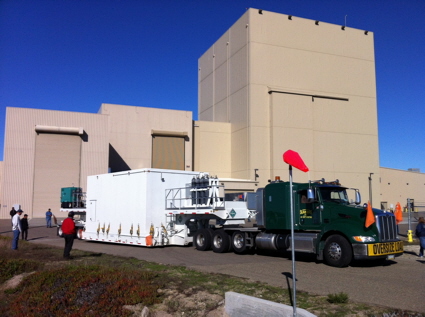
NASA's Landsat Data Continuity Mission (LDCM) spacecraft arrives at California's Vandenberg AFB in mid-December for pre-launch processing. LDCM is scheduled for launch from Vandenberg aboard an Atlas V rocket next spring. Image Credit: NASA/Jerry Nagy
(DEC 26) HERNDON, Va. -- Northrop Grumman Corporation (NYSE:NOC) recently supported the successful flight testing of the U.S. Air Force's Minuteman III intercontinental ballistic missile (ICBM) weapon system last month. More
(DEC 20) MOFFETT FIELD, Calif. - Scientists found treasure when they studied a meteorite that was recovered April 22, 2012 at Sutter's Mill, the gold discovery site that led to the 1849 California Gold Rush. More
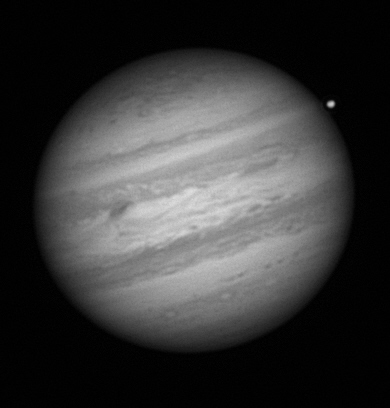
Jupiter's moon Io begins to disappear behind the giant planet late on the evening of December 6. Observers are treated to such events, known as occultations, on a daily basis thanks to the dance of Jupiter's four brightest moons around the planet. Astrophotographer Jim Ferreira recorded the event on December 6 at 23:59 PST from Livermore, Calif. using a 9.25-inch Schmidt-Cassegrain telescope, Wratten 25 (red) filter, and a DMK21 digital camera. Copyright 2012, Jim Ferreira. Used with permission.
Small satellites aim to enhance warfighter situational awareness
(DEC 13) TUCSON, Ariz. -- Raytheon Company (NYSE: RTN) was awarded a $1.5 million Defense Advanced Research Projects Agency (DARPA) contract for phase one of the agency's Space Enabled Effects for Military Engagements (SeeMe) program. During the next nine months, the company will complete the design for small satellites to enhance warfighter situational awareness in the battlespace.
The SeeMe program will provide useful on-demand imagery information directly to the warfighter in the field from a low-cost satellite constellation launched on a schedule that conforms to Department of Defense operational tempos.
For this contract, Raytheon has teamed with Sierra Nevada Corporation, University of Arizona and SRI International to assist with design work and eventually production. Next year, in phase two of the SeeMe program, the Raytheon team would build six satellites for ground testing.
Raytheon
(DEC 5) Hawthorne, CA -- The United States Air Force Space and Missile Systems Center has awarded SpaceX two Evolved Expendable Launch Vehicle (EELV)-class missions: DSCOVR (Deep Space Climate Observatory) and STP-2 (Space Test Program 2). To be launched on SpaceX's Falcon launch vehicles in 2014 and 2015 respectively, the awards mark the first EELV-class missions awarded to the company to date.
The DSCOVR mission will be launched aboard a Falcon 9 and is currently slated for late 2014, while STP-2 will be launched aboard the Falcon Heavy and is targeted for mid-2015. Both are expected to launch from Space Launch Complex 40 at Cape Canaveral Air Force Station, Florida.
The two missions will support the EELV certification process for both the Falcon 9 and Falcon Heavy. Falcon Heavy, the most powerful rocket in the world, is expected to take its first flight in the second half of 2013. Building on reliable flight proven architecture, the Falcon 9 and Falcon Heavy launch vehicles are designed for exceptional reliability, meeting the stringent U.S. Air Force requirements for the Evolved Expendable Launch Vehicle (EELV) program.
SpaceX
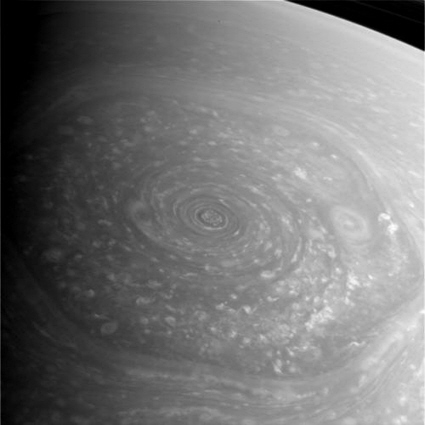
The complex structure of Saturn's north pole is revealed in this Cassini spacecraft image released on November 28. Cassini's wide-angle imaging camera took the image the previous day from a distance of about 233,742 miles (376,171 kilometers). The Jet Propulsion Laboratory in Pasadena, Calif. controls and manages the Cassini mission for NASA. Credit: NASA/JPL-Caltech/Space Science Institute
(NOV 28) SCHRIEVER AIR FORCE BASE, Colo. -- Members of the 1st and 7th Space Operations Squadrons took notice when an upper stage Russian rocket disintegrated in low earth orbit Oct. 16. More
(NOV 21) A big new sunspot (AR1618) has emerged near the center of the solar disk, and it is crackling with strong M-class solar flares. NOAA forecasters estimate a 70% chance of more M-flares today, and a 15% chance of powerful X-flares. If the rapid growth of AR1618 continues apace, the Thanksgiving holiday (USA) could be filled with stormy space weather.
SpaceWeather.com
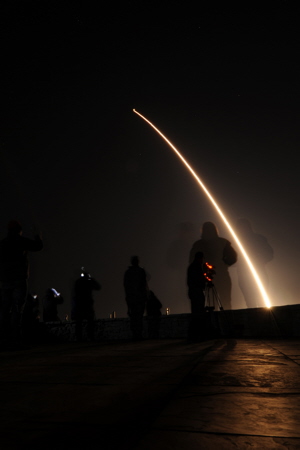
An Air Force Global Strike Command Minuteman III intercontinental ballistic missile equipped with a simulated re-entry vehicle was launched during an operational test at 3:07 a.m. Wednesday, Nov. 14, from Launch Facility 10 on North Vandenberg. U.S. Air Force photo by Levi Riendeau
(NOV 14) VANDENBERG AIR FORCE BASE, Calif. - An Air Force Global Strike Command Minuteman III intercontinental ballistic missile equipped with a simulated reentry vehicle was launched during an operational test at 3:07 a.m. Nov. 14 from Launch Facility 10 on North Vandenberg.
The purpose of the launch program is to validate and verify the effectiveness, readiness and accuracy of the weapon system, according to Air Force Global Strike Command officials.
30th Space Wing Western Range safety operations went as planned during the flight test.
The launch team, under the direction of the 576th Flight Test Squadron, included crew members from the 341st Missile Wing, Malmstrom AFB, Mont., and crew members from the 625th Strategic Operations Squadron, Offutt AFB, Neb., on board the Airborne Command Post E-6B aircraft. The launch was initiated by crew members on the aircraft employing the Airborne Launch Control System.
The 576 FLTS is responsible for installed tracking, telemetry and command destruct systems on the missile, which collect data and ensure safety requirements are met.
The entire ICBM community, including the Department of Defense, the Department of Energy, and U.S. Strategic Command will use the data collected from this mission for continuing force development evaluation.
Vandenberg AFB
(NOV 5) Scientists working with NASA's 230-foot-wide (70-meter) Deep Space Network antenna at Goldstone, Calif., have obtained several radar images depicting near-Earth asteroid 2007 PA8. More
(OCT 23) TUCSON, Ariz. - Scientists at the University of Arizona and in California have completed the most challenging large astronomical mirror ever made. More
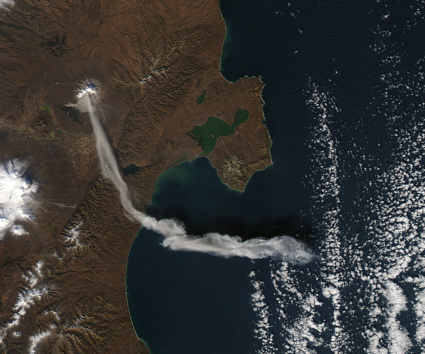
A plume of ash rises from the Shiveluch volcano, one of the biggest and most active volcanoes on Russia's Kamchatka Peninsula. The Moderate Resolution Imaging Spectroradiometer (MODIS) instrument aboard NASA's Aqua satellite acquired this true-color image of the volcano on October 6 at 01:50 UTC (1:50 p.m. local time). It is one of many detailed views of Earth's land areas, seas, and atmosphere returned by Aqua since its launch from Vandenberg Air Force Base in 2002. Image: NASA Goddard Spaceflight Center
(OCT 18) An astronomy graduate student at New Mexico State University is looking for possible signs of life on Mars by studying the possible detection of methane gas on the planet. More
(OCT 10) SANTA BARABARA, Calif. - Westmont's powerful Keck Telescope will focus on a planetary nebula known as the Blue Snowball (NGC 7662) during the monthly viewing of the stars, Friday Oct. 19. More
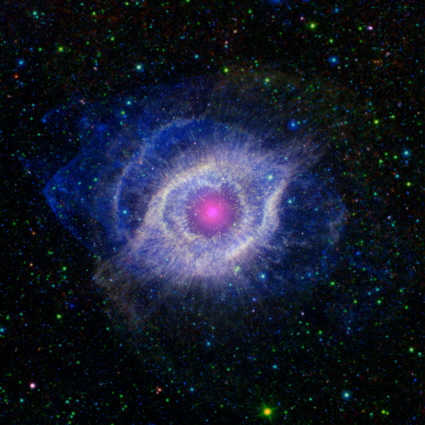
A dying star throws a cosmic tantrum in this composite image of the Helix Nebula from NASA's Spitzer Space Telescope, WISE spacecraft, and Galaxy Evolution Explorer (GALEX). The Helix nebula, also known as NGC 7293, lies 650 light-years away, in the constellation of Aquarius. In death, the star's dusty outer layers are unraveling into space, glowing from the intense ultraviolet radiation from the hot stellar core. Infrared data from Spitzer for the central nebula is rendered in green and red, with WISE data covering the outer areas in green and red. Ultraviolet data from GALEX appears as blue. WISE was launched from Vandenberg AFB, Calif. in 2009. Image: NASA/JPL-Caltech
(OCT 4) A satellite developed by student interns from San Jose State University, with mentoring and support from NASA's Ames Research Center, has been released from the International Space Station. More
(SEP 27) PASADENA, Calif. -- NASA's Curiosity rover mission has found evidence a stream once ran vigorously across the area on Mars where the rover is driving. More
With downtown San Francisco and the San Francisco Bay Bridge in the background, space shuttle Endeavour atop its modified 747 carrier aircraft overflies the former Alameda Naval Air Station during the Tour of California on September 21. The tour was Endeavour's final flight before it becomes a museum display in Los Angeles. Image courtesy NASA/Carla Thomas
(SEP 17) BERKELEY, Calif. - Early in the morning of September 12 the Dark Energy Camera (DECam), mounted on the Victor Blanco Telescope at the Cerro Tololo Inter-American Observatory in Chile, recorded its first images of a southern sky spangled with galaxies. More
(SEP 13) VANDENBERG AIR FORCE BASE, Calif. - Team Vandenberg launched a United Launch Alliance Atlas V rocket from Space Launch Complex-3 here Sept. 13 at 2:39 p.m.
It was the fifth Atlas V processed at Vandenberg and the 606th Atlas mission in U.S. history.
"It's an honor to work alongside the men and women of Team Vandenberg, United Launch Alliance, the National Reconnaissance Office and our mission partners," said Col. Nina Armagno, 30th Space Wing commander. "These synergistic relationships are what guide Vandenberg to continual mission success and lead us into the next generation of spaceport excellence."
Western range launch operations were executed without incident.
The rocket carried a national security payload for the National Reconnaissance Office.
Vandenberg's next launch is a Minuteman III scheduled for Nov. 14.
Vandenberg AFB
(SEP 13) WHITE SANDS MISSILE RANGE, N.M. - White Sands Missile Range conducted a missile test today producing a contrail visible from as far away as Phoenix, Az., Las Vegas, Nev., and Salt Lake City, Utah.
The test of the Patriot Advanced Capability 3 or PAC-3 missile was conducted using a Juno missile as a target. The Juno was launched from Fort Wingate near Gallup N.M., and flew to White Sands Missile Range to be intercepted by the PAC-3.
The sunlight lit up the contrail from the Juno creating a light show. The Juno performed as expected. This was the 14th time a large ballistic target missile has been fired from Fort Wingate since 1998. The contrail has not always been visible from so far away depending upon the time of day and atmospheric conditions.
Range personnel coordinated the test with FAA and other authorities to ensure that the test was conducted safely. The White Sands work force is experienced in conducting complex missile testing.
White Sands Missile Range is member of the Army Test and Evaluation Command and is a premiere test location for the Army, Navy and Air Force, as well as foreign and civilian customers.
White Sands Missile Range
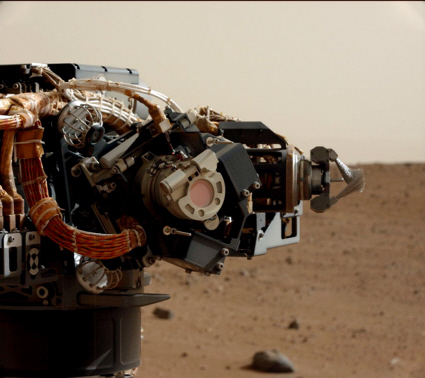
The complex wiring and hardware of the arm on NASA's Curiosity Mars rover are visible in this view returned from the rover's Mast Camera on September 5. The major components include the Mars Hand Lens Imager (MAHLI) and Curiosity's dust removal tool, a motorized wire brush. The Curiosity mission is managed by the Jet Propulsion Laboratory in Pasadena, Calif. Image courtesy NASA/JPL-Caltech/MSSS
(SEP 7) VANDENBERG AIR FORCE BASE, Calif. - A United Launch Alliance Atlas V rocket carrying a National Reconnaissance Office payload is scheduled to be launched by team Vandenberg from Space Launch Complex-3 here Thursday at 2:39 p.m.
The launch, originally scheduled for Aug. 2, was postponed when a range instrumentation issue developed during countdown. The issue has been resolved and the range is ready to support a safe and successful launch.
Vandenberg AFB
(AUG 29) An infrared astronomy satellite launched from Vandenberg AFB in 2009 has revealed millions of black holes. More

An iceberg nearly as large as Connecticut floats in the waters of the South Atlantic. The MODIS instrument aboard NASA's Aqua spacecraft imaged the object during a pass on August 20. The iceberg, known as B 15F, formed in 2002 March when it separated from the Ross Ice Shelf. By August 20, B 15F had drifted to the Bellingshausen Sea, to the west side of the Antarctic Peninsula, or almost 1/4 of the way around Antarctica from its birthplace. The image is one of numerous interesting views of Earth returned by Aqua since its launch from Vandenberg AFB in 2002. Image courtesy of Jeff Schmaltz MODIS Land Rapid Response Team, NASA GSFC
(AUG 22) Vandenberg Air Force Base, Calif. - The launch of an Atlas V carrying the National Reconnaissance Office NROL-36 payload is being rescheduled. The NROL-36 mission leadership has established a new launch date of Sept. 13 and a request for this new launch date on the range has been submitted to the 30th Space Wing. The previously planned launch date of Sept. 6 was not available on the range and mission managers have elected to revise the launch date to Sept. 13 as preferred for overall operational considerations. The team working to implement the corrective actions for the range issue with the Mission Flight Control Center (MFCC) is currently finalizing the implementation, test and certification of the MFCC corrective actions. There are no issues being worked with either the Atlas V vehicle or the NROL-36 space vehicle and they remain secured in the Mobile Service Tower at Space Launch Complex-3 at Vandenberg Air Force Base.
United Launch Alliance
(AUG 13) Vandenberg Air Force Base, Calif. - The launch of an Atlas V carrying the National Reconnaissance Office NROL-36 payload is being rescheduled following a range instrumentation issue that developed during the initial launch attempt Aug. 2. The NROL-36 mission leadership has requested a new launch date of Sept. 6 and the 30th Space Wing is now working with range and support agencies to support this request. The team working to implement the corrective actions for the range issue with the Mission Flight Control Center (MFCC) is working to have the MFCC corrective actions implemented, tested and certified by late August. There are no issues being worked with either the Atlas V vehicle or the NROL-36 space vehicle and they remain secured in the Mobile Service Tower at Space Launch Complex-3 at Vandenberg Air Force Base.
United Launch Alliance
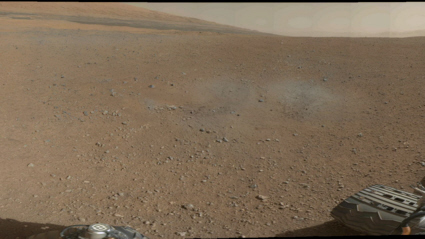
On August 9, the Jet Propulsion Laboratory released this portion of the first color 360-degree panorama from Curiosity, NASA's newest Mars rover. The mission's destination, a mountain at the center of Gale Crater called Mount Sharp, is visible in the distance, to the left. Blast marks from the rover's descent stage are in the foreground. The Curiosity mission is managed by the Jet Propulsion Laboratory in Pasadena, Calif., a division of the California Institute of Technology. Image courtesy NASA/JPL-Caltech/MSSS
(AUG 10) VANDENBERG AIR FORCE BASE, Calif. - Vandenberg officials postponed the launch of an Atlas V rocket carrying a National Reconnaissance Office payload Thursday to provide additional time for resolution of a range instrumentation issue that developed during the initial launch attempt Aug 2.
The launch will take place no earlier than Aug. 30.
"The malfunction occurred in our Mission Flight Control Center, which gives our mission flight control officer the ability to terminate flight should we need to for safety reasons," said Lt. Col. Burton Catledge, 2nd Range Operations Squadron commander. "Our team is working hard to resolve the issue, test and recertify the equipment to support safe launch operations."
There are no issues with the Atlas V vehicle or the NROL-36 space vehicle.
The rocket is slated to launch from Vandenberg's Space Launch Complex-3.
Vandenberg AFB
(AUG 3) VANDENBERG AIR FORCE BASE, Calif. - The launch of an Atlas V rocket carrying a National Reconnaissance Office payload has been further delayed to no earlier than Aug. 14 here to provide additional time for resolution of a range instrumentation issue that developed during the initial launch attempt Aug 2.
"The instrumentation currently experiencing issues is a mandatory range asset critical to public safety," said Col. Nina Armagno, 30th Space Wing commander and Launch Decision Authority for this launch. "As operators of America's West Coast spaceport, public safety is Vandenberg's top priority during launch operations, which is why we are taking this time to ensure our range instrumentation is ready to support a safe and successful launch."
There are no issues with the Atlas V vehicle or the NROL-36 space vehicle.
The rocket is slated to launch from Vandenberg's Space Launch Complex-3.
Vandenberg AFB

A satellite-based map released this week shows a dramatic loss of ice from Greenland's ice sheet between 2012 July 8 (left) and 2012 July 12 (right). Son Nghiem of NASA's Jet Propulsion Laboratory in Pasadena, Calif. was analyzing radar data from the India's Oceansat-2 satellite when he noticed that most of Greenland appeared to have undergone surface melting on July 12. Data from Terra and Aqua, NASA satellites previously launched from Vandenberg AFB, and a U.S. Air Force meteorological satellite, confirmed the discovery. Image credit: Jesse Allen, NASA Earth Observatory and Nicolo E. DiGirolamo, SSAI and Cryospheric Sciences Laboratory
(JUL 25) TUCSON, Ariz. -- The Missile Defense Agency awarded Raytheon Company (NYSE: RTN) a $925 million contract for development of the Standard Missile-3 Block IIA missile, which is a co-development effort between the U.S. and Japan.
"As the threat continues to evolve, so does our ability to counter that threat," said Dr. Taylor W. Lawrence, president of Raytheon Missile Systems. "We're honored to work with our Japanese allies to bring this next-generation defensive capability to the world."
Used by the U.S. and Japanese navies to destroy short- to intermediate-range ballistic missiles, the SM-3 is the only defensive weapon of its kind. The SM-3 Block IIA will have a 21-inch 2nd and 3rd stage rocket motor and a larger, more capable kinetic warhead.
On track for a 2018 deployment date, the missile is the third evolution of the SM-3 family of missiles and builds on the successful legacy of the first two variants: SM-3 Block IA and SM-3 Block IB. The SM-3 program has achieved 21 successful intercepts.
"The SM-3 IIA's larger rocket motors will allow for a greater defended area, which is an important factor when it comes to protecting both the U.S. and our NATO allies," said Wes Kremer, vice president of the Air and Missile Defense Systems product line for Raytheon Missile Systems.
SM-3 Block IA missiles are currently employed on Japan's Kongo-class ships. Raytheon has delivered more than 130 SM-3 variants to the U.S. and Japanese navies on time and on budget.
Raytheon
(JUL 20) WASHINGTON -- A telescope launched July 11 aboard a NASA sounding rocket has captured the highest-resolution images ever taken of the sun's million-degree atmosphere called the corona. More
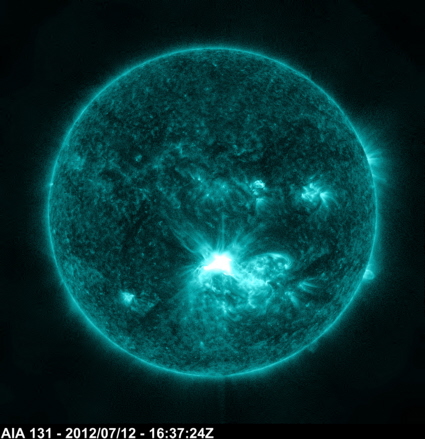
Sunspot AR1520 erupted on July 12, producing a powerful x-class solar flare and sending a coronal mass ejection directly toward Earth. Just hours after the eruption, a stream of protons arrived at Earth, causing minor disruption to the Global Positioning System and high-latitude radio blackouts. The arrival of the CME on July 14 at 11:00 PDT markedly degraded HF (shortwave) radio propagation. NASA's Solar Dynamics Observatory recorded this ultraviolet image of AR1520 (bright area) on July 12 just moments before the flare and CME. Information courtesy of NASA and www.spaceweather.com. Photo courtesy of NASA
(JUL 9) TUCSON, Ariz., -- Raytheon Company (NYSE: RTN) was awarded a $636 million development and sustainment contract to provide the Exoatmospheric Kill Vehicle to The Boeing Company, which is the prime contractor for the Ground-based Midcourse Defense program. More
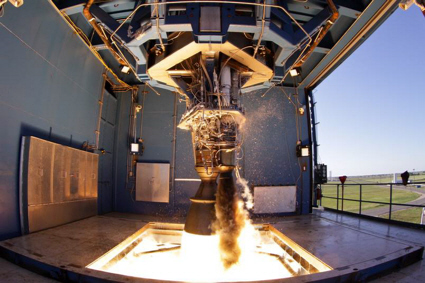
Fire spews from a hot fire test of a Merlin 1D rocket engine on June 25. Hawthorne, Calif.-based SpaceX is developing the engine to power its Falcon 9 and Falcon 9 Heavy rockets. The engine fired for 185 seconds and produced 147,000 pounds of thrust, the full duration and power required for a Falcon 9 rocket launch. The test took place at SpaceX's rocket development facility in McGregor, Texas. Image courtesy of SpaceX
(JUN 28) WASHINGTON -- Data from NASA's Cassini spacecraft have revealed Saturn's moon Titan likely harbors a layer of liquid water under its ice shell. More
(JUN 19) NASA will launch a University of Colorado experiment to image the sun on a NASA two-stage Black Brant IX suborbital sounding rocket at 1:00 p.m. MDT (3 p.m. EDT) June 23 from the White Sands Missile Range, N.M.
The flight will be an under-flight calibration for the Extreme Ultraviolet Variability Experiment (EVE) that is onboard NASA's Solar Dynamics Observatory (SDO) satellite.
The EVE Program will provide solar EUV irradiance data for NASA's Living with the Star program, including near real-time data products for use in operational atmospheric models that specify the space environment and to assist in forecasting space weather operations.
The EVE program also will advance understanding of the physics of the solar EUV irradiance variations on time scales from flares to the solar cycle. This progress, which includes providing better predictions, will result from simultaneous measurements of the EUV irradiance and full Sun images of magnetic fields brightness at Wavelengths emitted from the chromospheres, transition region, and corona, which are obtained by other SDO instruments.
EVE is headed by Dr. Thomas Woods of the Laboratory for Atmospheric and Space Physics, University of Colorado, Boulder.
NASA
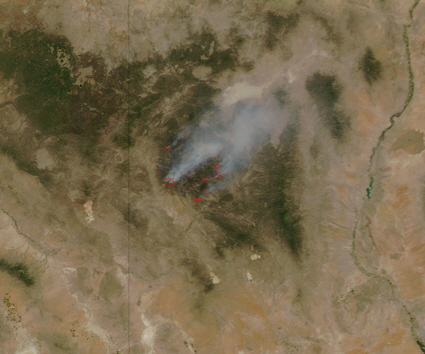
The largest fire in New Mexico's history, the Whitewater-Baldy Complex Fire, burns in extreme and inaccessible terrain in this Aqua satellite image taken 2012 June 6. The Moderate Resolution Imaging Spectroradiometer (MODIS) aboard the spacecraft captured the true-color image at 20:50 UTC (14:50 local time). Image courtesy of Jeff Schmaltz MODIS Land Rapid Response Team, NASA GSFC
(JUN 14) Active sunspot AR1504 is facing Earth and hurling coronal mass ejections (CMEs) in our direction. A fast-moving CME that left the sun on June 14th is expected to scoop up another CME already en route and deliver a double-blow to Earth's magnetic field on June 16th. Weak-to-moderate geomagnetic storms are possible when the clouds arrive. Check http://spaceweather.com for images and updates.
SpaceWeather.com
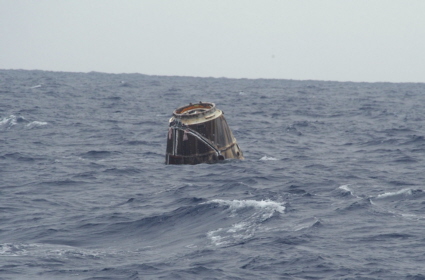
The Dragon spacecraft floats in the Pacific Thursday following the first-ever commercial cargo mission to the International Space Station. Dragon was built and launched by Hawthorne, California-based SpaceX. Image courtesy of SpaceX/ Michael Altenhofen
(MAY 30) VANDENBERG AIR FORCE BASE, Calif. - Preparations for the second landing of the X-37B, the Air Force's unmanned, reusable space plane, are underway at Vandenberg Air Force Base.
While the exact landing date and time will depend on technical and weather considerations, it is expected to occur during the early- to mid-June timeframe. Space professionals from the 30th Space Wing will monitor the de-orbit and landing of the Air Force's X-37B Orbital Test Vehicle mission, called OTV-2.
The X-37B launched March 5, 2011, from Cape Canaveral Air Force Station, Fla. Since then, Vandenberg crews have conducted extensive, periodic training in preparation for landing. "The men and women of Team Vandenberg are ready to execute safe landing operations anytime and at a moment's notice," said Col. Nina Armagno, 30th Space Wing commander.
More information will be released as it becomes available.
Vandenberg AFB
(MAY 23) WASHINGTON -- NASA Television will air a live program starting at 5:30 p.m. EDT Tuesday, June 5, showcasing the celestial phenomenon of the planet Venus trekking across the face of the sun. More

A black sky meets Earth in this view from a balloon as it climbed to the edge of space above southern California on May 5th. The balloon was built by students from Santa Barbara's Anacapa School, reached a maximum altitude of 111,814 feet, and returned live video and data during its three-hour flight. Image courtesy of Anacapa School
(MAY 15) PASADENA, Calif. - NASA's Jet Propulsion Laboratory, Pasadena, Calif., invites the public to its annual Open House on Saturday, June 9, and Sunday, June 10, from 9 a.m. to 4 p.m. More
(MAY 12) The Lompoc Record reports the Minuteman III test launch scheduled for May 16th from Vandenberg AFB has been postponed due to a technical problem.
The problem involves a command receiver decoder used in the missile's flight termination system. The flight termination system allows ground controllers to remotely destroy the missile in the event of an anomaly.
According to the article, the problem is currently under investigation and a new launch date has not been announced.
The Lompoc Record story is available online at http://www.lompocrecord.com/news/local/minuteman-test-delayed-from-may/article_8d8ac16c-9acd-11e1-94c4-001a4bcf887a.html
Brian Webb
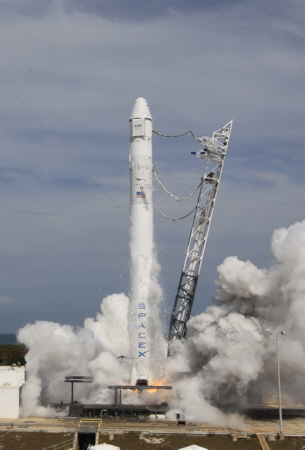
Fire erupts from SpaceX's Falcon 9 rocket during a test firing of the vehicle's engines at Cape Canaveral Air Force Station, Fla. on April 30th. The test was conducted in preparation for the rocket's upcoming May 19th launch. The Hawthorne, Calif.-based firm plans to use the rocket to send an unmanned Dragon cargo craft on a mission to the International Space Station. Image courtesy of SpaceX
(MAY 4) LOS ANGELES AIR FORCE BASE, El Segundo, Calif. -- The U.S. Air Force successfully launched the second Advanced Extremely High Frequency spacecraft at 2:42 p.m. EDT, May 4 from Space Launch Complex 41 at Cape Canaveral Air Force Station, Fla. The satellite was carried aboard an Atlas V launch vehicle.
AEHF is a joint service satellite communications system that will provide survivable, global, secure, protected, and jam-resistant communications for high-priority military ground, sea and air assets. The AEHF system is the follow-on to the Milstar system, augmenting, improving and expanding the Department of Defense's MILSATCOM architecture.
AEHF-2 was procured from Lockheed Martin Space Systems Company by the MILSATCOM Systems Directorate, part of the Air Force Space Command's Space and Missile Systems Center. The MILSATCOM Systems Directorate plans, acquires and sustains space-based global communications in support of the president, secretary of defense and combat forces. The MILSATCOM enterprise consists of satellites, terminals and control stations and provides communications for more than 16,000 air, land and sea platforms.
Los Angeles AFB
(APR 23) LAS CRUCES, NM - When the sun goes down, researchers and staff at New Mexico State University's Apache Point Observatory go into high gear, mapping the universe one pinpoint at a time for the Sloan Digital Sky Survey III project. More
Numerous sunspots accompany a recent upswing in solar activity in this Solar Dynamics Observatory image taken April 22. Two important measures of solar activity - the sunspot number and solar flux index - had temporarily been in decline since early March. The 11-year solar cycle is expected to peak in early 2013. Image courtesy NASA
(APR 17) SANTA BARBARA, Calif. - Mars, the red planet, will be the focus for stargazers at a free, public viewing with the powerful Keck Telescope Friday, April 20. The event, which begins about 8 p.m., lasts several hours. The observatory opens its doors to the public every third Friday of the month in conjunction with the Santa Barbara Astronomical Unit, whose members bring their own telescopes to Westmont for the public to gaze through. In case of inclement or overcast weather, please call the Telescope Viewing Hotline at (805) 565-6272 and check the Westmont website to see if the viewing has been canceled.
Westmont physics instructor Thomas Whittemore says Mars will lie in the constellation Leo that evening. "It'll only be about 11 arc seconds in diameter, so seeing any detail on the red planet will be difficult," he says. "Only under the steadiest seeing conditions will we have any hope of getting a glimpse of any detail on Mars, but we will try."
While the telescope is still pointing up in the direction of Leo, Whittemore says he'll aim the Keck Telescope beyond Mars and into the realm of the galaxies. "Among the spring's finest galaxy groupings is the Leo Trio, a triplet of galaxies that includes M65, M66 and NGC3628," he says. "Lying some 35 million light-years away, NGC3628 is a spiral galaxy discovered by Sir William Herschel in 1784. With a diameter of 300,000 light-years, it has about three times the extent of our own Milky Way Galaxy. Since we see it edge-on, it shows a wonderful dust lane that divides the galaxy in half, making it look like a cosmic hot dog."
The viewing may also include two contrasting, open clusters in Cancer, the crab. "One of these, M44, also known as the Beehive Cluster, was first seen in a telescope by Galileo in 1609," Whittemore says. "He counted about 40 stars in this spectacular gem, second only in its dazzle to the Pleiades. The stars in M44 are somewhat young by stellar standards, estimated to be about 600 to 700 million years old."
Westmont students and faculty use the 24-inch reflector telescope to conduct astronomical research. The Keck Telescope is housed in the observatory between Russell Carr Field and the track and field/soccer complex. Free parking is available near the baseball field.
Westmont College
(APR 12) WASHINGTON -- Astronomers are actively hunting a class of supermassive black holes throughout the universe called blazars thanks to data collected by NASA's Wide-field Infrared Survey Explorer (WISE). More
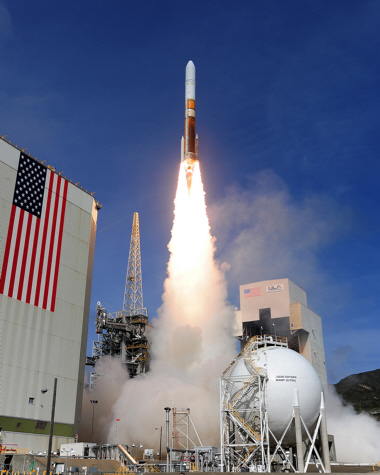
A United Launch Alliance Delta IV Medium+ (5,2) leaves Space Launch Complex-6 at Vandenberg AFB on April 3. U.S. Air Force photo by Rodney Jones
(APR 3) VANDENBERG AIR FORCE BASE, Calif. - Team Vandenberg launched a United Launch Alliance Delta IV Medium+ (5,2) from Space Launch Complex-6 here at 4:12 p.m. PDT today.
"The teamwork between the 30th Space Wing, the National Reconnaissance Office, United Launch Alliance and numerous other agencies was seamless," said Col. Nina Armagno, 30th Space Wing commander and launch decision authority. "It's this synergistic mindset and attention to detail that led to our amazing launch today."
The Delta IV carried a national security payload for the National Reconnaissance Office.
Team Vandenberg's next scheduled launch is a Minuteman III flight test, scheduled for April 10.
Vandenberg AFB
(APR 1) Vandenberg Air Force Base, Calif. - The launch of a Delta IV carrying a national security payload for the National Reconnaissance Office is delayed until April 3. The team is continuing to review data from an observation on the upper stage engine and requires additional time to complete its final assessment prior to launch. The launch is now planned for Tuesday, April 3 from Space Launch Complex-6 at 4:12 p.m. PDT Vandenberg Air Force Base in California. The forecast shows a 40 percent chance of favorable weather conditions for launch.
United Launch Alliance
(MAR 23) VANDENBERG AIR FORCE BASE, Calif. - Team Vandenberg is scheduled to launch a United Launch Alliance Delta IV Medium+ (5,2) rocket carrying a national security payload at 3:30 p.m. March 29 from Space Launch Complex-6 here.
"This will be the Department of Defense's first-ever launch of a Delta IV configured with a 5-meter payload fairing and two solid rocket motors," said Lt. Col. Brady Hauboldt, 4th Space Launch Squadron commander. The solid rocket motors each add nearly 225,000 pounds of thrust to augment the Delta IV's 650,000 pounds of main engine thrust.
Col. Nina Armagno, 30th Space Wing commander is the launch decision authority.
Vandenberg's 4th Space Launch Squadron has overseen launch vehicle mission assurance for this Delta IV since it arrived last fall. The squadron will join operators from across the 30th Space Wing, Space and Missile Systems Center, National Reconnaissance Office and United Launch Alliance for this launch.
"The 4th Space Launch Squadron formed in 1994 to support Titan missions at Vandenberg's Space Launch Complex-4, then re-activated in 2003 to operate the Atlas V and Delta IV launch systems," said Hauboldt. "Today we execute Western Range Evolved Expendable Launch Vehicle spacelift operations with a combined team of engineers, space operators, program managers and missile maintenance technicians."
Vandenberg AFB
The entire sky as seen in the infrared is captured in this mosaic of images from NASA's Wide-field Infrared Survey Explorer (WISE) spacecraft. The mosaic was released on March 14th as NASA unveiled a new atlas and catalog of the entire infrared sky showing more than a half billion stars, galaxies and other objects captured by the WISE mission. WISE was launched from California's Vandenberg Air Force Base aboard a Delta rocket in 2009. Image courtesy of NASA/JPL-Caltech/UCLA
(MAR 12) SANTA BARBARA, Calif. - Weather permitting, Westmont's powerful Keck Telescope will be available to Central Coast stargazers Friday, March 16, beginning at about 8 p.m. and lasting several hours. The observatory opens its doors to the public every third Friday of the month in conjunction with the Santa Barbara Astronomical Unit, whose members bring their own telescopes to Westmont for the public to gaze through. In case of inclement weather, please call the Telescope Viewing Hotline at (805) 565-6272 and check the Westmont website to see if the viewing has been cancelled.
Westmont students and faculty use the 24-inch reflector telescope to conduct astronomical research. The Keck Telescope is housed in the observatory between Russell Carr Field and the track and field/soccer complex. Free parking is available near the baseball field.
Westmont physics instructor Thomas Whittemore says we don't need a telescope to see a spectacular near-conjunction of Venus and Jupiter in the west. "These two planets have been closing in on one another for the last month or so," he says. "On March 13 they were about 3 degrees apart. Now Venus, the brighter of the two, is moving up and away from Jupiter. They set a little after 10:30 this evening, but are still wonderful objects to see glowing above the northwestern horizon around 10."
Westmont College
(MAR 11) One and perhaps two CMEs are expected to hit Earth's magnetic field today. Of particular interest is a CME launched toward Earth by a powerful M8-class eruption on March 10. Forecasters say the cloud could spark minor to severe geomagnetic storms when it arrives on March 11-12. High-latitude sky watchers should be alert for auroras tonight.
spaceweather.com
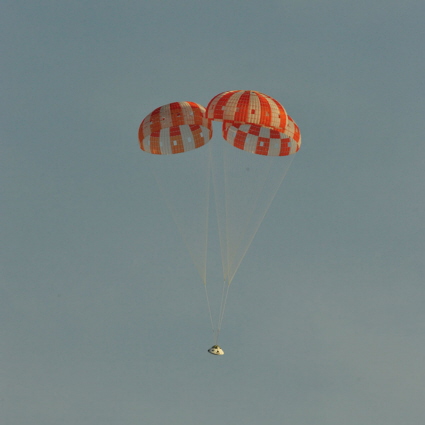
A model of NASA's Orion spacecraft descends following release from an Air Force C-17 cargo plane high above Arizona during a test on February 29. The drop examined the disturbance of the airflow behind the spacecraft. The event was the latest in a series of parachute drop tests conducted by NASA at the U.S. Army's Proving Grounds in Yuma, Arizona. Orion is being developed for the exploration of space beyond low Earth orbit. Photo courtesy of NASA
(FEB 28) BARKSDALE AIR FORCE BASE, La. - The launch of an unarmed operational test Minuteman III intercontinental ballistic missile at Vandenberg AFB, Calif., has been postponed.
The test launch is delayed in order to replace a test-unique tracking component used only on test missiles. The test-unique tracking component monitors missile location within geographic boundaries of the test range.
This tracking system is used solely in test launches of Minuteman III missiles and does not affect the operational reliability, accuracy or performance of the system.
The launch has not yet been rescheduled.
Air Force Global Strike Command
(FEB 25) VANDENBERG AIR FORCE BASE, Calif. -- An unarmed Minuteman III intercontinental ballistic missile was launched during an operational test at 2:46 a.m. Feb. 25 from Launch Facility-09 on north Vandenberg.
Col. Nina Armagno, 30th Space Wing commander, was the launch decision authority. 30th Space Wing Western Range safety operations went as planned during the flight test.
"Extensive resources are devoted to every launch mission to ensure safety in our local area and downrange," said Armagno. "Public safety is my first priority during all launch operations."
Vandenberg AFB
The height of the world's forests is visible in this accurate, high-resolution map (click to enlarge) released by the Jet Propulsion Laboratory (JPL), Pasadena, Calif. on February 17. Scientists from JPL, the University of Maryland, and Woods Hole Research Center created the map using 2.5 million pulse measurements collected by NASA's ICESat satellite and other data from the Terra and TRMM satellites and the Space Shuttle. The map will help scientists better understand the role forests play in climate change and how their heights influence wildlife habitats within them, while also helping them quantify the carbon stored in Earth's vegetation. Image courtesy NASA/JPL-Caltech
(FEB 14) A new NASA satellite instrument that makes a quantum leap forward in detector technology has arrived at Orbital Sciences Corp. in Gilbert, Ariz. More
(FEB 8) A powerful instrument designed to give scientists more refined information about Earth's atmosphere and improve weather and climate forecasts is now active and sending its first data back to Earth from America's newest polar-orbiting satellite. More
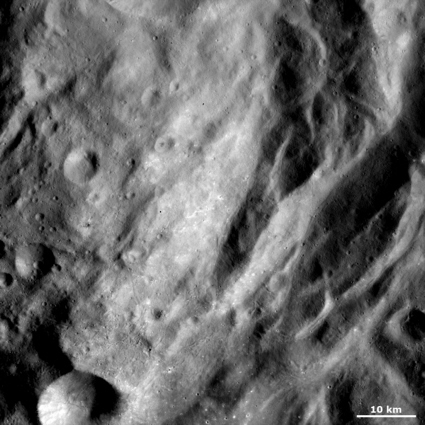
Undulating terrain in the asteroid Vesta's southern hemisphere is visible in this image from NASA's Dawn spacecraft released February 1. The terrain consists of linear, curving hills and depressions, which are most distinct in the right of the image. Many narrow, linear grooves run in various directions across this undulating terrain. There are some craters, less than 0.6 miles (1 kilometer) in diameter, in the bottom of the image. The Dawn mission to the asteroids Vesta and Ceres is managed by the Jet Propulsion Laboratory for NASA. UCLA is responsible for overall Dawn mission science. Image courtesy NASA/JPL-Caltech/UCLA/MPS/DLR/IDA
(FEB 1) Hawthorne, CA - Space Exploration Technologies (SpaceX) has successfully test fired SuperDraco, a powerful new engine that will play a critical role in the company's efforts to change the future of human spaceflight. More
(JAN 24) LOS ANGELES AIR FORCE BASE, El Segundo, Calif. - The U.S. Air Force has stopped work on the Defense Weather Satellite System to implement the FY 2012 National Defense Authorization Act and FY12 Consolidated Appropriations Act.
The Defense Weather Satellite System was created out of the Executive Office of the President restructure of the National Polar-orbiting Operational Environmental Satellite System program into separate civil and military space programs in February of 2010.
Northrop Grumman Aerospace Systems is the prime contractor for the military DWSS program and is responsible for developing the satellite including the Visible/Infrared Imager Radiometer Suite provided by a subcontract with Raytheon Space and Airborne Systems.
Today the Air Force Defense Meteorological System Program constellation of satellites continues to provide high-quality and timely weather data to forecasters with two more satellites yet to be launched.
Los Angeles AFB
(JAN 22) If the sky is clear, sky watchers in the Southwest and beyond can see a close pairing of the night sky's two brightest objects next week. The celestial pairing occurs on the evening of January 26 when the Moon's slow eastward movement takes it approximately 7 degrees from the planet Venus.
Although the objects will appear to be close to one another, Venus will actually lie some 105 million miles behind the crescent Moon.
To see the close pairing, look in the southwest about 25 minutes after sunset. All you'll need to see the dusk duo are clear skies and the unaided eye.
Brian Webb
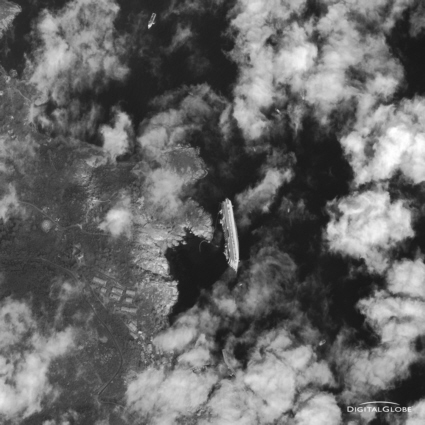
The cruise ship Costa Concordia lies on her side after striking a reef off of Giglio, Italy on Friday, January 13. DigitalGlobe's WorldView-1 commercial reconnaissance satellite recorded this amazing view of the disaster from orbit. WorldView-1 was launched aboard a Delta II rocket from Vandenberg AFB, Calif. on 2007 September 18. Image courtesy of DigitalGlobe
(JAN 13) Astronomers from the California Institute of Technology and the University of Arizona have released the largest data set ever collected that documents the brightening and dimming of stars and other celestial objects 200 million in total. More

Fresh snow from a New Year storm blankets the Rocky Mountains and surrounding areas on January 2. The Moderate Resolution Imaging Spectroradiometer (MODIS) aboard NASA's Aqua satellite captured this true-color image during a pass over the region early that afternoon. The features visible in this view include the Gulf of California (lower left corner) and the Great Salt Lake (green area near the upper left margin). Image courtesy Jeff Schmaltz, MODIS Land Rapid Response Team, NASA GSFC
(JAN 2) TUCSON, Ariz. - The Steward Observatory Mirror Lab on the University of Arizona campus offers a unique opportunity to experience the groundbreaking work being done at our facility, located under the UA football stadium.
The mirror lab is renowned for developing and implementing technologies that enable production of the world's largest and most challenging ground-based telescope mirrors.
A tour provides visitors with a behind-the-scenes look at cutting-edge optical technology and the revolutionary spin-casting processes involved in making these giant telescope mirrors.
Starting with the construction of the mold, to spin-casting, to grinding and polishing, the final result is a lightweight mirror ready for transportation to a mountaintop observatory where it will peer into remote regions of the cosmos, exploring the edges of the universe in an effort to answer a vast array of astronomical questions and make new discoveries.
Tours are conducted at 1 p.m and 3 p.m. Monday through Friday. Advance reservations are required and can be made by calling 520-626-8792.
Admission: $15 adults, $8 students
Audience: All, Small (1-50)
University of Arizona
Copyright © 2012-2013, Brian Webb. All rights reserved.